United States HVAC Equipment Market Size
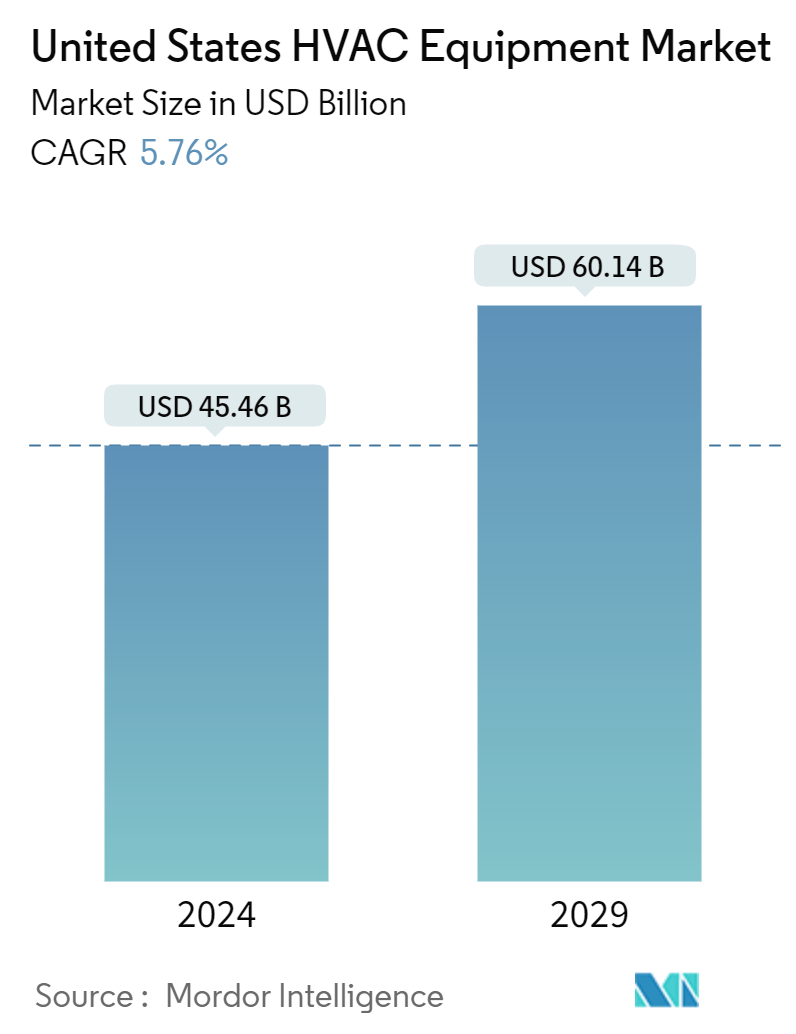
| Study Period | 2019 - 2029 |
| Base Year For Estimation | 2023 |
| Market Size (2024) | USD 45.46 Billion |
| Market Size (2029) | USD 60.14 Billion |
| CAGR (2024 - 2029) | 5.76 % |
| Market Concentration | Medium |
Major Players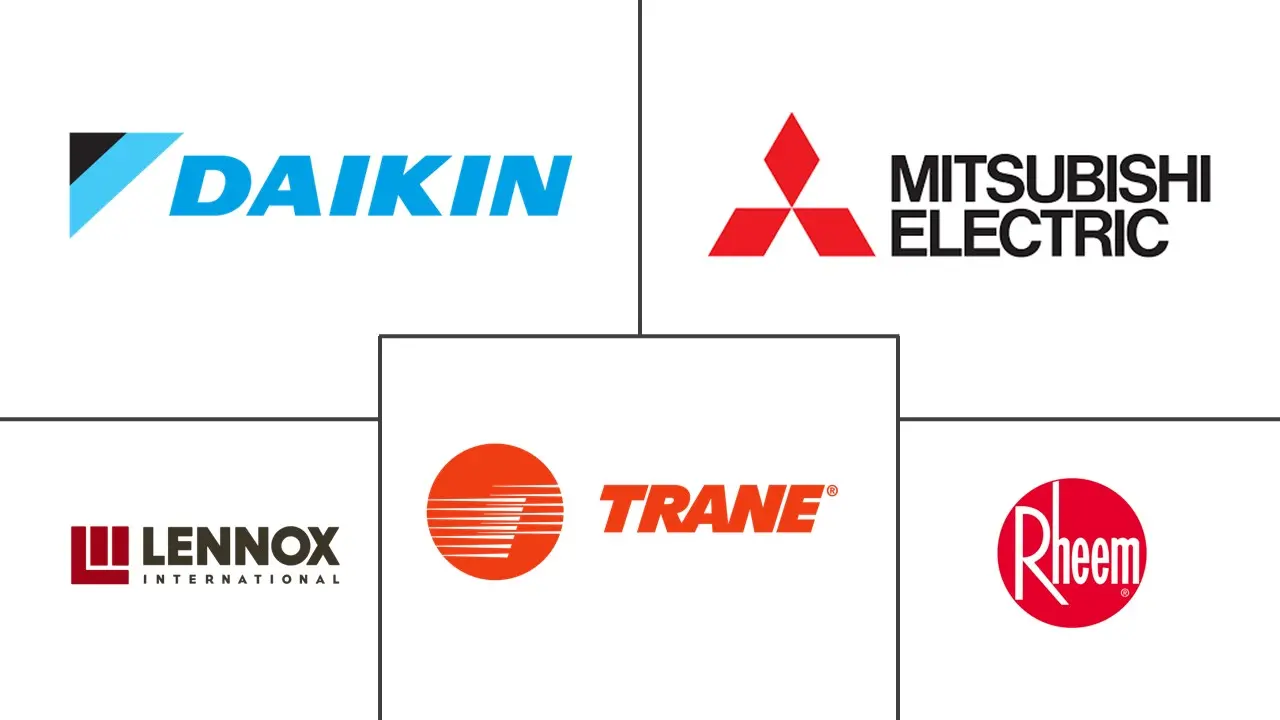
*Disclaimer: Major Players sorted in no particular order |
United States HVAC Equipment Market Analysis
The United States HVAC Equipment Market size is estimated at USD 45.46 billion in 2024, and is expected to reach USD 60.14 billion by 2029, growing at a CAGR of 5.76% during the forecast period (2024-2029).
The HVAC equipment market is thriving in the United States, fueled by various factors. Given the vast geographic expanse of the United States, temperatures can swing from extreme cold to intense heat, varying by state, city, and coast. This climatic variability makes HVAC installations essential in residential/commercial spaces. As a result, the pressing need to regulate indoor temperatures, regardless of external weather conditions, bolsters the HVAC industry's growth in the nation.
• In the United States, the government is ramping up its building renovation projects to enhance energy efficiency. These energy-efficient upgrades curtail greenhouse gas emissions and lower energy bills for homeowners and businesses. They bolster indoor air quality, underscoring their significance for public health and fostering a conducive environment for market growth.
• For example, in June 2024, the US General Services Administration (GSA) Administrator unveiled an investment plan: channeling USD 80 million from the Inflation Reduction Act (IRA) into intelligent building technologies. These technologies aim to cut emissions, boost efficiency, trim costs, and elevate comfort levels across approximately 560 federal buildings.
• The growing consumer awareness regarding sustainability and energy efficiency is also driving the country's adoption of smart home technologies, creating a favorable ecosystem for the growth of innovative HVAC systems. For instance, according to the Consumer Technology Association (CTA), the US smart home hardware sales revenue was estimated to reach USD 23.5 billion in 2023, compared to USD 19.70 billion in 2018. Hence, the confluence of such trends is expected to support the studied market's growth during the forecast period.
• Factors such as higher energy consumption, especially of legacy/older HVAC systems, and the high cost of replacement and new installation challenge the studied market's growth. The impact of such trends has intensified in recent years owing to the changing geopolitical dynamics between the United States and China, as trade restrictions continue to influence the supply chain and pricing of components/HVAC systems in the region.
• Starting in 2023, new regulations mandate that all HVAC systems in the country must achieve a seasonal energy efficiency ratio (SEER) between 14 and 15. Arizona legislators argue that these new mandates further strain an already challenging real estate market. They are advocating for a six-month extension to ease compliance, but this request remains unapproved.
• With the introduction of these mandates and the gradual elimination of specific refrigerants in residential air conditioning, the HVAC industry is witnessing a surge in demand for replacement systems that align with the new standards. While these advanced systems promise enhanced energy efficiency and environmental benefits, inflationary pressures and other factors are inflating their costs. Suppliers project a cost increase of up to 20%, translating to steeper prices for homeowners in 2023.
United States HVAC Equipment Market Trends
Residential Sector to be the Largest End User
- In the United States, the residential HVAC segment is set to experience significant growth. This surge is largely attributed to the country's varied climatic conditions, which demand a range of HVAC equipment.
- For example, the World Bank highlights the climatic diversity in the United States, from the tropical warmth of southern Florida and Hawaii to the frigid arctic conditions of Alaska. The continental United States showcases a pronounced temperature gradient, with southern coastal states averaging over 21°C annually, contrasting sharply with the cooler northern regions near the Canadian border. Seasonal temperature swings are notable, with differences reaching up to 50°C in the northern plains between summer and winter.
- The growing concerns over indoor air quality are driving the expansion of the HVAC market in the residential sector. In addition, various regional governments are promoting the adoption of high-efficiency HVAC equipment. They are doing this by enforcing laws to meet energy demands and introducing sales programs that offer air conditioners at discounted prices. By consistently updating the Energy Labelling Program to favor energy-efficient systems, these governments are fostering an environment conducive to the growth of the HVAC market.
- As construction activity rises, the smart home industry is witnessing consolidation. With energy consumption in buildings on the rise, IoT-enabled HVAC systems are gaining traction. These trends are fueling the growth of the heating, ventilation, and air conditioning market. The expanding residential construction sector is driving the demand for HVAC installations, catering to diverse needs like space heating, cooling, ventilation, and water heating.
- According to the US Census Bureau, Texas and Florida led the nation in 2023, issuing over 190,000 residential building permits. In contrast, Alaska and Rhode Island lagged behind, issuing the fewest permits of any state. Hence, the growing construction activities, along with the increasing consumer adoption of HVAC in the residential housing segment, are anticipated to drive opportunities in the studied market during the forecast period.
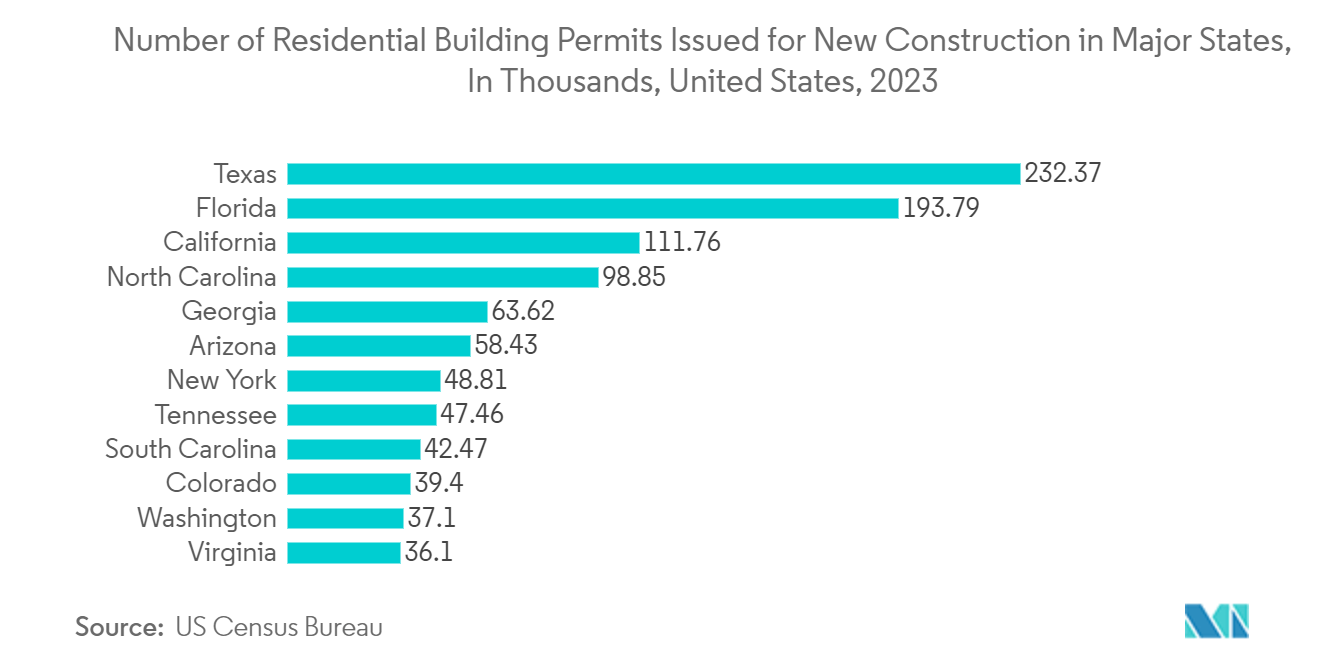
Southern States of the US to Hold Major Market Share
- The southern states of the United States are witnessing a burgeoning market influenced by the region's hot and humid climate, urbanization, and economic growth. With some of the nation's highest temperatures and extended hot seasons, HVAC systems have become indispensable in nearly every Southern home, ensuring consistent demand in the residential market. States such as Texas, Florida, Louisiana, and Georgia show a pronounced reliance on air conditioning systems.
- Texas, home to the nation's second-largest population at approximately 30 million, has seen a consistent uptick in home sales since 2012, culminating in 327,921 sales in 2023. Similarly, Florida, another populous state in the South, recorded 257,697 home sales in 2023, as per state realtor data. Both states are experiencing a significant surge in new home constructions, with Texas notably setting record growth rates. These housing developments are fueling the rising demand for HVAC systems.
- In March 2024, the head of the State Energy Conservation Office (SECO) announced that Texas would apply for USD 690 million in residential energy efficiency rebates. This funding backs two new programs introduced by the Inflation Reduction Act: Home Energy Rebates and Home Electrification and Appliance Rebates.
- The Home Energy Rebates program incentivizes projects like insulation and HVAC upgrades that reduce energy consumption. The rebate amount scales with energy savings: projects achieving a 20-35% reduction can receive up to USD 4,000, while those exceeding 35% can get up to USD 8,000. Such incentives are poised to boost the demand for HVAC systems significantly.
- According to the data provided by the US Census Bureau, in 2023, the Southern United States outpaced all other regions combined in new housing starts. The West followed as the second region, recording approximately 400,800 housing starts in 2021. Notably, the Northeast was the sole US region to see a rise in housing starts in 2022.
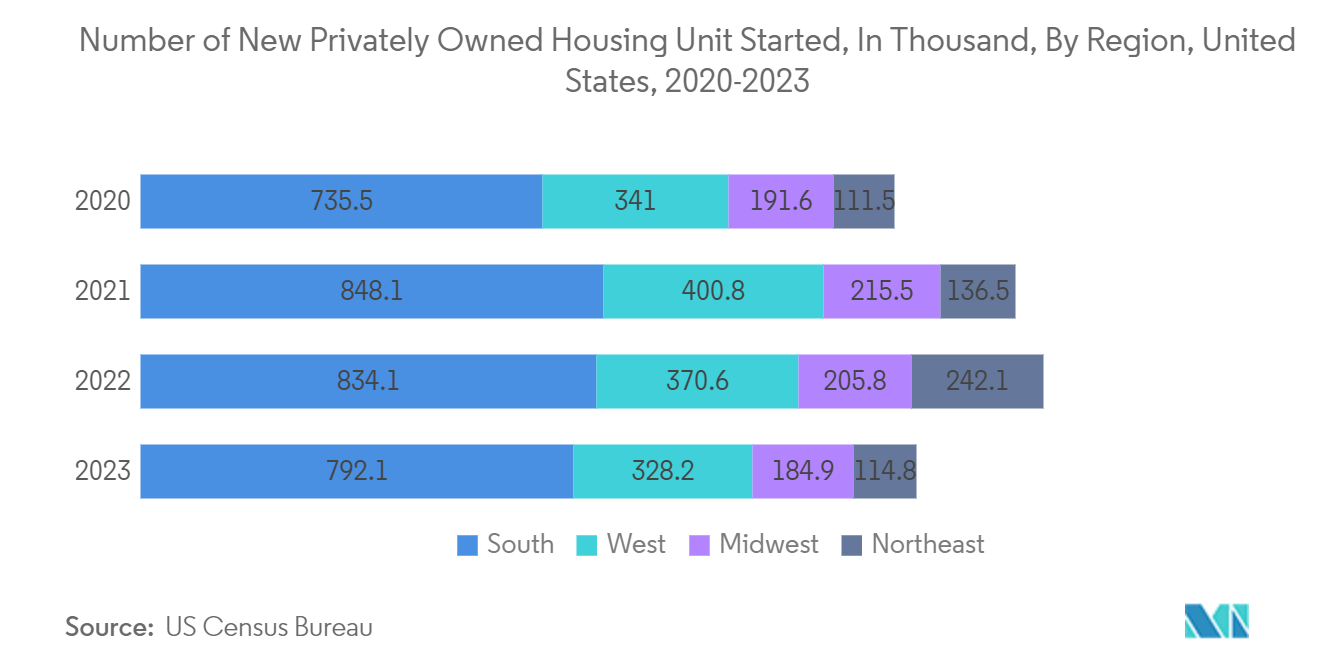
United States HVAC Equipment Industry Overview
The US HVAC equipment market features a diverse array of vendors, including industry leaders such as Daikin, Lennox, Trane, Mitsubishi Corporation, Nortek Air, Ingersoll Rand, and Carrier. These companies serve a wide spectrum of end customers. With the growing adoption of HVAC systems across residential, commercial, and industrial sectors, there has been a marked uptick in strategic execution plans, primarily driven by a heightened focus on exploring new revenue avenues.
Companies are aligning their strategies with industry peers to navigate the shifting technological and regulatory landscape and broadening their reach through inorganic methods like mergers and acquisitions. This trend is poised to heighten competition among market players in the coming years.
Market vendors are channeling investments into product development, capacity enhancement, and geographical expansion, all in response to the rising acceptance of HVAC technology. Key competitive strategies in play include acquisitions, partnerships with industry players, and the introduction of new products and services.
Given the industry's fragmented nature, partnerships and alliances have surfaced as pivotal competitive strategies. As a result, vendors are increasingly seeking collaborations with technology providers to enhance their integrated service offerings.
United States HVAC Equipment Market Leaders
-
Daikin Industries Ltd
-
Lennox International Inc.
-
Rheem Manufacturing Company
-
Trane Inc. (Trane Technologies PLC)
-
Mitsubishi Electric Hydronics & IT Cooling Systems (Mitsubishi Electric Corporation)
*Disclaimer: Major Players sorted in no particular order
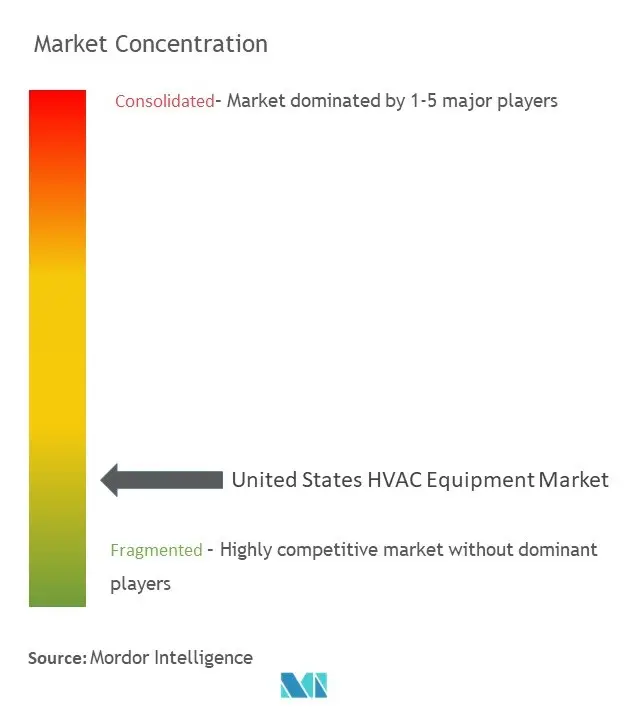
United States HVAC Equipment Market News
- August 2024 - Daikin Applied unveiled its latest self-contained HVAC system, the SWP J-Vintage. This cost-effective and highly efficient unit is upgraded with the low-global warming potential (GWP) R-32 refrigerant. Tailored for floor-by-floor applications, the SWP J-Vintage is packed with features that empower customers to shrink their carbon footprint, all while ensuring top-notch performance at reduced costs.
- May 2024 - Lennox and Samsung, a globally trusted brand with 40 years of pioneering HVAC technology, inked a deal to form a joint venture. This venture is expected to focus on selling ductless AC and heat pump products (including mini-split, multi-split, and VRF) across the United States and Canada. The newly minted entity is expected to operate under the name Samsung Lennox HVAC North America.
US HVAC Equipment Market Report - Table of Contents
1. INTRODUCTION
- 1.1 Study Assumptions and Market Definition
- 1.2 Scope of the Study
2. RESEARCH METHODOLOGY
3. EXECUTIVE SUMMARY
4. MARKET INSIGHTS
- 4.1 Market Overview
-
4.2 Industry Attractiveness - Porter's Five Forces Analysis
- 4.2.1 Bargaining Power of Suppliers
- 4.2.2 Bargaining Power of Buyers
- 4.2.3 Threat of New Entrants
- 4.2.4 Threat of Substitute Products
- 4.2.5 Intensity of Competitive Rivalry
- 4.3 Industry Value Chain Analysis
- 4.4 Impact of Macroeconomic Factors and COVID-19 on the HVAC Industry
- 4.5 HVAC Industry in the United States - Current Employment, Number of Enterprises, Major Hotspots in the US
5. MARKET DYNAMICS
-
5.1 Market Drivers
- 5.1.1 Growing Adoption of Home and Building Automation Systems
- 5.1.2 Increasing Demand for Energy-efficient Devices
-
5.2 Market Challenges
- 5.2.1 High Energy Consumption of HVAC Equipment and Cost of Advanced HVAC Systems
6. MARKET SEGMENTATION
-
6.1 By Type of Equipment
- 6.1.1 Air Conditioning Equipment
- 6.1.1.1 Unitary Air Conditioners
- 6.1.1.2 Room Air Conditioners
- 6.1.1.3 Packaged Terminal Air Conditioners
- 6.1.1.4 Chillers
- 6.1.2 Heating Equipment
- 6.1.2.1 Warm Air Furnace (Gas and Oil)
- 6.1.2.2 Boilers
- 6.1.2.3 Room and Zone Heating Equipment
- 6.1.2.4 Heat Pumps (Air-sourced and Geo-thermal)
- 6.1.3 Ventilation Equipment
- 6.1.3.1 Air Handling Units
- 6.1.3.2 Fan Coil Units
- 6.1.3.3 Building Humidifiers and Dehumidifiers
-
6.2 By End User
- 6.2.1 Residential
- 6.2.2 Commercial
- 6.2.3 Industrial
-
6.3 By Region
- 6.3.1 West
- 6.3.2 South
- 6.3.3 Midwest
- 6.3.4 Northeast
7. PERCENTAGE INDICATION OF DEMAND (2023 Vs 2029) BY EFFICIENCY RATING - QUALITATIVE ANALYSIS
- 7.1 Heat Pumps (Low HSPF 8 to 8.99 Vs. High HSPF 9 and Above)
- 7.2 Residential Gas Furnaces (Low - < 90% AFUE Vs. High >=90% AFUE)
- 7.3 Residential Oil Furnaces (Low - <85% AFUE Vs. High >=85% AFUE)
- 7.4 Residential Gas Boilers (Low - <90% AFUE Vs. High - >=90% AFUE)
- 7.5 Residential Oil Boilers (Low - <87% AFUE Vs. High - >=87% AFUE)
- 7.6 Commercial Boilers (Low - <94% Thermal Efficiency Vs. High - >=94% Thermal Efficiency)
- 7.7 Room Air Conditioning (Low - 13 SEER Vs. High - > 13 SEER)
- 7.8 Light Commercial HVAC (Low -13 SEER Vs. High - > 13 SEER)
8. COMPETITIVE LANDSCAPE
-
8.1 Company Profiles*
- 8.1.1 Daikin Industries Ltd
- 8.1.2 Lennox International Inc.
- 8.1.3 Rheem Manufacturing Inc.
- 8.1.4 Trane Inc. (Trane Technologies PLC)
- 8.1.5 Mitsubishi Electric Hydronics & IT Cooling Systems (Mitsubishi Electric Corporation)
- 8.1.6 Nortek Air Solutions LLC (Madison Air)
- 8.1.7 Carrier Corporation
- 8.1.8 NIBE Group
- 8.1.9 LG Electronics Inc.
- 8.1.10 Midea Group
- 8.1.11 SystemAir AB
- 8.1.12 Johnson Controls International PLC
- 8.1.13 Greenheck Fan Corporation
- 8.1.14 TROX GmBH
9. VENDOR RANKING ANALYSIS
10. FUTURE OUTLOOK OF THE MARKET
** Subject To AvailablityUnited States HVAC Equipment Industry Segmentation
HVAC equipment ensures thermal comfort and maintains acceptable indoor air quality in indoor and vehicular environments. This technology plays a crucial role in various settings, including residential structures like single-family homes, apartment complexes, hotels, and senior living facilities. In addition, it is vital for medium-to-large industrial and office buildings, such as hospitals, where conditions like temperature and humidity are meticulously regulated using fresh outdoor air to ensure safety and health.
The market is defined by the revenue accrued from the sales of HVAC equipment of different types by major market players in the United States. The study also tracks the key market parameters, underlying growth influencers, and major vendors operating in the industry, which supports the market estimations and growth rates over the forecast period.
The US HVAC equipment market is segmented by type of equipment (air conditioning equipment [unitary air conditioners, room air conditioners, packaged terminal air conditioners, and chillers], heating equipment [warm air furnace [gas and oil], boilers, room & zone heating equipment, heat pumps [air-sourced and geothermal], and ventilation equipment [air handling units, fan coil units, building humidifiers, and dehumidifiers]), end user (residential, commercial, and industrial), region (West, South, Midwest, and Northeast). The market sizes and forecasts are provided in terms of value (USD) for all the above segments.
| By Type of Equipment | Air Conditioning Equipment | Unitary Air Conditioners |
| Room Air Conditioners | ||
| Packaged Terminal Air Conditioners | ||
| Chillers | ||
| By Type of Equipment | Heating Equipment | Warm Air Furnace (Gas and Oil) |
| Boilers | ||
| Room and Zone Heating Equipment | ||
| Heat Pumps (Air-sourced and Geo-thermal) | ||
| By Type of Equipment | Ventilation Equipment | Air Handling Units |
| Fan Coil Units | ||
| Building Humidifiers and Dehumidifiers | ||
| By End User | Residential | |
| Commercial | ||
| Industrial | ||
| By Region | West | |
| South | ||
| Midwest | ||
| Northeast |
US HVAC Equipment Market Research FAQs
How big is the United States HVAC Equipment Market?
The United States HVAC Equipment Market size is expected to reach USD 45.46 billion in 2024 and grow at a CAGR of 5.76% to reach USD 60.14 billion by 2029.
What is the current United States HVAC Equipment Market size?
In 2024, the United States HVAC Equipment Market size is expected to reach USD 45.46 billion.
Who are the key players in United States HVAC Equipment Market?
Daikin Industries Ltd, Lennox International Inc., Rheem Manufacturing Company, Trane Inc. (Trane Technologies PLC) and Mitsubishi Electric Hydronics & IT Cooling Systems (Mitsubishi Electric Corporation) are the major companies operating in the United States HVAC Equipment Market.
What years does this United States HVAC Equipment Market cover, and what was the market size in 2023?
In 2023, the United States HVAC Equipment Market size was estimated at USD 42.84 billion. The report covers the United States HVAC Equipment Market historical market size for years: 2019, 2020, 2021, 2022 and 2023. The report also forecasts the United States HVAC Equipment Market size for years: 2024, 2025, 2026, 2027, 2028 and 2029.
US HVAC Equipment Industry Report
Statistics for the 2024 US HVAC Equipment market share, size and revenue growth rate, created by Mordor Intelligence™ Industry Reports. US HVAC Equipment analysis includes a market forecast outlook 2029 and historical overview. Get a sample of this industry analysis as a free report PDF download.



